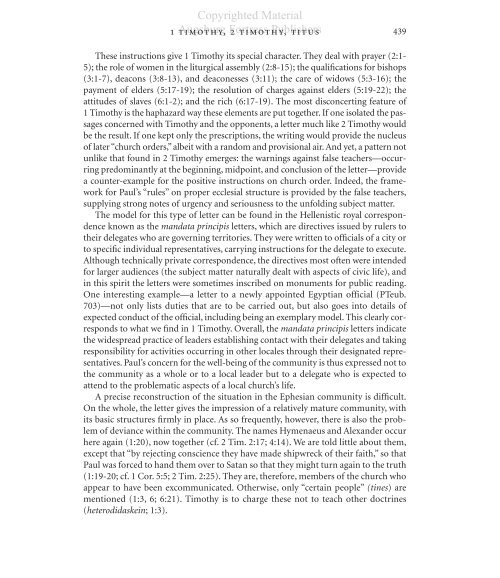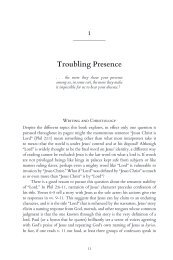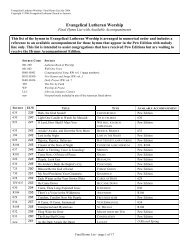19. Pastoral Letters: 1 Timothy, 2 Timothy, Titus - Augsburg Fortress
19. Pastoral Letters: 1 Timothy, 2 Timothy, Titus - Augsburg Fortress
19. Pastoral Letters: 1 Timothy, 2 Timothy, Titus - Augsburg Fortress
You also want an ePaper? Increase the reach of your titles
YUMPU automatically turns print PDFs into web optimized ePapers that Google loves.
Copyrighted Material<br />
1 <strong>Augsburg</strong> timothy, <strong>Fortress</strong> 2 timothy, Publishers titus 439<br />
These instructions give 1 <strong>Timothy</strong> its special character. They deal with prayer (2:1-<br />
5); the role of women in the liturgical assembly (2:8-15); the qualifications for bishops<br />
(3:1-7), deacons (3:8-13), and deaconesses (3:11); the care of widows (5:3-16); the<br />
payment of elders (5:17-19); the resolution of charges against elders (5:19-22); the<br />
attitudes of slaves (6:1-2); and the rich (6:17-19). The most disconcerting feature of<br />
1 <strong>Timothy</strong> is the haphazard way these elements are put together. If one isolated the passages<br />
concerned with <strong>Timothy</strong> and the opponents, a letter much like 2 <strong>Timothy</strong> would<br />
be the result. If one kept only the prescriptions, the writing would provide the nucleus<br />
of later “church orders,” albeit with a random and provisional air. And yet, a pattern not<br />
unlike that found in 2 <strong>Timothy</strong> emerges: the warnings against false teachers—occurring<br />
predominantly at the beginning, midpoint, and conclusion of the letter—provide<br />
a counter-example for the positive instructions on church order. Indeed, the framework<br />
for Paul’s “rules” on proper ecclesial structure is provided by the false teachers,<br />
supplying strong notes of urgency and seriousness to the unfolding subject matter.<br />
The model for this type of letter can be found in the Hellenistic royal correspondence<br />
known as the mandata principis letters, which are directives issued by rulers to<br />
their delegates who are governing territories. They were written to officials of a city or<br />
to specific individual representatives, carrying instructions for the delegate to execute.<br />
Although technically private correspondence, the directives most often were intended<br />
for larger audiences (the subject matter naturally dealt with aspects of civic life), and<br />
in this spirit the letters were sometimes inscribed on monuments for public reading.<br />
One interesting example—a letter to a newly appointed Egyptian official (PTeub.<br />
703)—not only lists duties that are to be carried out, but also goes into details of<br />
expected conduct of the official, including being an exemplary model. This clearly corresponds<br />
to what we find in 1 <strong>Timothy</strong>. Overall, the mandata principis letters indicate<br />
the widespread practice of leaders establishing contact with their delegates and taking<br />
responsibility for activities occurring in other locales through their designated representatives.<br />
Paul’s concern for the well-being of the community is thus expressed not to<br />
the community as a whole or to a local leader but to a delegate who is expected to<br />
attend to the problematic aspects of a local church’s life.<br />
A precise reconstruction of the situation in the Ephesian community is difficult.<br />
On the whole, the letter gives the impression of a relatively mature community, with<br />
its basic structures firmly in place. As so frequently, however, there is also the problem<br />
of deviance within the community. The names Hymenaeus and Alexander occur<br />
here again (1:20), now together (cf. 2 Tim. 2:17; 4:14). We are told little about them,<br />
except that “by rejecting conscience they have made shipwreck of their faith,” so that<br />
Paul was forced to hand them over to Satan so that they might turn again to the truth<br />
(1:19-20; cf. 1 Cor. 5:5; 2 Tim. 2:25). They are, therefore, members of the church who<br />
appear to have been excommunicated. Otherwise, only “certain people” (tines) are<br />
mentioned (1:3, 6; 6:21). <strong>Timothy</strong> is to charge these not to teach other doctrines<br />
(heterodidaskein; 1:3).




